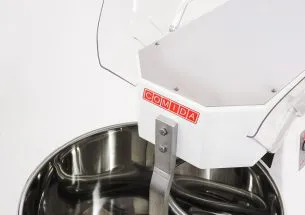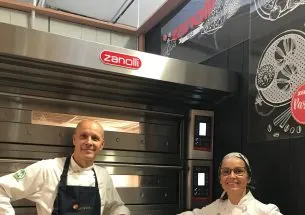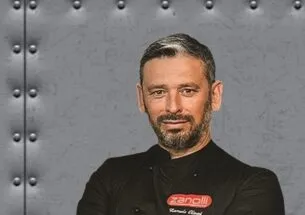Dialogue with a young pioneer of takeaway pizza 2.0 on equipment, laboratory organization, cost reduction and futuristic methods.
You have already started 3 takeaway pizzerias and you have one opening shortly in Verona. When you have to organize the laboratory what do you take into account? On a practical and costs level, are there important elements to be known and foreseen so as not to be caught unprepared?
Alessandro Facci: When I started the business 8 years ago, I had a very small laboratory and you know that in the beginning those who start up pay attention to expenses. As the business developed, I learned to adapt. It’s definitely necessary to have a suitably sized laboratory for production. As production demands increased, I had to move. I now have a 70-80 m2 laboratory, suited to production for my shops. I produce and store balls for pizzerias and precooked pizza bases in the laboratory, then distribute them to pizzerias and wholesalers respectively. It is important to manage the available spaces well and not to pile things up, to move well and not to work with additional stress. I always inquire about machinery, I go to try them out. Many companies, like Zanolli, offer the possibility of testing the machinery with your dough, it is worth taking advantage of! On the internet you can often also find demonstration material that can help determine if that is the right machine. I am wary of all those promotional offers and sales on the internet that can be more harmful than convenient. Fairs are also useful in this regard.
Are there any special subsidies in Italy?
A. F.: For the first opening, I took part in a tender that offered subsidies for our category of craftsmen: the government gave a non-repayable 15%. There are so many types of possibilities like these, it is important to be well informed. We must also consider that these are long procedures and the repayments arrive after a long time. The bureaucratic part is laborious, and we must be very careful. It is advisable to rely on a bank or competent reference structures.
 What Zanolli equipment did you choose for your laboratories and how do you use them?
What Zanolli equipment did you choose for your laboratories and how do you use them?
A. F.: I bought an Ercolina divider and rounder and a 120 kg Galassia Pane dough mixer machine from Comida. From Zanolli electric pizza ovens, I chose the Teorema Polis static oven and the Synthesis air ventilated tunnel oven for the Villafranca laboratory. I have a larger Synthesis in the Verona pizzeria, which I will use for cooking fresh dough balls rolled out by hand, put on wire gauze and stuffed. We will also use it to grill vegetables, make confit tomatoes … It has been chosen because it is multipurpose and guarantees constancy in the result and above all it avoids the need for skilled labour. Today we spend a lot to find staff and to train them. The Synthesis is accessible even for less experienced personnel. I use wood and gas for the take-away in Villafranca, while for other preparations and when I have to try something, given its versatility, I use Teorema Polis, which is also a bread oven. For pre-cooked pizzas, sometimes I like to give a little bit of moisture to the Polis first and then finish cooking in the Synthesis. For on-peel pizzas, I first cook them in the Polis, then I let them cool and complete the cooking in the Synthesis, which dries them and gives them crispness. Having various models, I can play around.
What steps do you take to optimize energy consumption and reduce food waste?
A. F.: We fully process the product from all the ingredients we receive. Despite having sophisticated fillings, we do not make gourmet pizzas that require complicated processing. For us it is important to achieve a balance between original fillings and processes that allow managing the pace of a takeaway pizzeria: very high turnover in very short times. Last year we made a big investment: ovens, blast chillers and vacuum chamber machines. We throw away almost nothing of our product, everything is processed and then chilled. Chilling is the future; it is a great help in reducing the waste of perishable raw materials. We also opted to organize the entire production in a single laboratory to reduce costs: it is worth having just one machine, even if larger, instead of three small ones. Thus, so even for the staff: having just one person in charge of production instead of three means a significant reduction in costs. Not to mention that the centralized laboratory allows us to have the same product for all pizzerias. We produce everything there, then we distribute to the outlets.
Will you keep the takeaway pizza format?
A. F.: Many people ask me. Last year I got close to opening a pizzeria, but then I invested in delivery. I am not against pizzerias with seating, but I know that the trend for the next ten years will be the takeaway, also because it allows for less costs. It follows that the customer pays a little less for the pizza in proportion. My initial strength was delivery and I decided to focus on this format, since I can use my experience as a competitive advantage to be at the forefront. The delivery sector is constantly increasing, that can be seen from the proliferation of dedicated platforms and applications.
 What inspires you in creating your pizzas? How do you get the combination of style and taste? What ingredients do you use?
What inspires you in creating your pizzas? How do you get the combination of style and taste? What ingredients do you use?
A. F.: I prefer doughs done using the direct method and many times at room temperature. I work with the change of time, playing with yeasts. I do not use starters for take-away activities because they would become unmanageable, I use them for fairs, events, etc. I have three types of dough: classic, Neapolitan, wholewheat. I change the price list every six months and add a new dough. They are direct doughs with 24/48 hours of leavening, with very low amounts of yeast. There are processes in which I use the indirect method, for example that for the Neapolitan pizza. The classic pizza, which is the one I produce the most, has a direct method. For events or on commission I also make pan pizza, on-peel pizza… and there I give free rein to my expression. Many times, when I am stressed, I let off steam by going to my lab to do something new. The combinations come from trips I have made, from the restaurants where I ate, looking at blogs, recipes, new products seen at fairs, seasonality, local ingredients. In addition, there is always a particular inspiration, the desire to bring new things and anticipate trends. The Verona project mainly involves the use of local ingredients, such as mozzarella from the milk from Lessinia mountain pastures.
Local ingredients and technologies inspired by the USA; it seems a winning combination!
A. F.: In fact, America was sort of a milestone for me: when I returned from my trip, I told myself that I absolutely had to bring myself up to date and started working on an app that was ahead of its time. Despite being from the country my pizzerias have innovative elements. The three Facci la Pizza takeaways are destined for the provinces, while the Facci Pizza Delivery, the Verona one, is destined to take root in the big cities and is a format that I would also like to take abroad. The Verona project has a very futuristic footprint with an almost completely automated line. For example, the Synthesis tunnel oven will guarantee a constant production line, while at the front desk level we will have order totems. You can order from the totem or via our app that allows automated ordering, automated delivery and online payment. We have designed this application as a tool to make life easier for customers and point of sale managers, we are very proud of it. Obviously, it is essential to never stop researching and being open to change. A pizza maker once told me “you must get used to not getting used”. It is a philosophy that proved to be successful for my team and me.
The Zanolli team is always available for customized advisory on the opening of take away pizzerias. Feel free to contact us!
Dr. Zanolli Srl
Tel. +39 045 8581500 – www.zanolliovens.com – zanolli@zanolli.it
Dialogue with a young pioneer of takeaway pizza 2.0 on equipment, laboratory organization, cost reduction and futuristic methods.
You have already started 3 takeaway pizzerias and you have one opening shortly in Verona. When you have to organize the laboratory what do you take into account? On a practical and costs level, are there important elements to be known and foreseen so as not to be caught unprepared?
Alessandro Facci: When I started the business 8 years ago, I had a very small laboratory and you know that in the beginning those who start up pay attention to expenses. As the business developed, I learned to adapt. It’s definitely necessary to have a suitably sized laboratory for production. As production demands increased, I had to move. I now have a 70-80 m2 laboratory, suited to production for my shops. I produce and store balls for pizzerias and precooked pizza bases in the laboratory, then distribute them to pizzerias and wholesalers respectively. It is important to manage the available spaces well and not to pile things up, to move well and not to work with additional stress. I always inquire about machinery, I go to try them out. Many companies, like Zanolli, offer the possibility of testing the machinery with your dough, it is worth taking advantage of! On the internet you can often also find demonstration material that can help determine if that is the right machine. I am wary of all those promotional offers and sales on the internet that can be more harmful than convenient. Fairs are also useful in this regard.
Are there any special subsidies in Italy?
A. F.: For the first opening, I took part in a tender that offered subsidies for our category of craftsmen: the government gave a non-repayable 15%. There are so many types of possibilities like these, it is important to be well informed. We must also consider that these are long procedures and the repayments arrive after a long time. The bureaucratic part is laborious, and we must be very careful. It is advisable to rely on a bank or competent reference structures.
 What Zanolli equipment did you choose for your laboratories and how do you use them?
What Zanolli equipment did you choose for your laboratories and how do you use them?
A. F.: I bought an Ercolina divider and rounder and a 120 kg Galassia Pane dough mixer machine from Comida. From Zanolli electric pizza ovens, I chose the Teorema Polis static oven and the Synthesis air ventilated tunnel oven for the Villafranca laboratory. I have a larger Synthesis in the Verona pizzeria, which I will use for cooking fresh dough balls rolled out by hand, put on wire gauze and stuffed. We will also use it to grill vegetables, make confit tomatoes … It has been chosen because it is multipurpose and guarantees constancy in the result and above all it avoids the need for skilled labour. Today we spend a lot to find staff and to train them. The Synthesis is accessible even for less experienced personnel. I use wood and gas for the take-away in Villafranca, while for other preparations and when I have to try something, given its versatility, I use Teorema Polis, which is also a bread oven. For pre-cooked pizzas, sometimes I like to give a little bit of moisture to the Polis first and then finish cooking in the Synthesis. For on-peel pizzas, I first cook them in the Polis, then I let them cool and complete the cooking in the Synthesis, which dries them and gives them crispness. Having various models, I can play around.
What steps do you take to optimize energy consumption and reduce food waste?
A. F.: We fully process the product from all the ingredients we receive. Despite having sophisticated fillings, we do not make gourmet pizzas that require complicated processing. For us it is important to achieve a balance between original fillings and processes that allow managing the pace of a takeaway pizzeria: very high turnover in very short times. Last year we made a big investment: ovens, blast chillers and vacuum chamber machines. We throw away almost nothing of our product, everything is processed and then chilled. Chilling is the future; it is a great help in reducing the waste of perishable raw materials. We also opted to organize the entire production in a single laboratory to reduce costs: it is worth having just one machine, even if larger, instead of three small ones. Thus, so even for the staff: having just one person in charge of production instead of three means a significant reduction in costs. Not to mention that the centralized laboratory allows us to have the same product for all pizzerias. We produce everything there, then we distribute to the outlets.
Will you keep the takeaway pizza format?
A. F.: Many people ask me. Last year I got close to opening a pizzeria, but then I invested in delivery. I am not against pizzerias with seating, but I know that the trend for the next ten years will be the takeaway, also because it allows for less costs. It follows that the customer pays a little less for the pizza in proportion. My initial strength was delivery and I decided to focus on this format, since I can use my experience as a competitive advantage to be at the forefront. The delivery sector is constantly increasing, that can be seen from the proliferation of dedicated platforms and applications.
 What inspires you in creating your pizzas? How do you get the combination of style and taste? What ingredients do you use?
What inspires you in creating your pizzas? How do you get the combination of style and taste? What ingredients do you use?
A. F.: I prefer doughs done using the direct method and many times at room temperature. I work with the change of time, playing with yeasts. I do not use starters for take-away activities because they would become unmanageable, I use them for fairs, events, etc. I have three types of dough: classic, Neapolitan, wholewheat. I change the price list every six months and add a new dough. They are direct doughs with 24/48 hours of leavening, with very low amounts of yeast. There are processes in which I use the indirect method, for example that for the Neapolitan pizza. The classic pizza, which is the one I produce the most, has a direct method. For events or on commission I also make pan pizza, on-peel pizza… and there I give free rein to my expression. Many times, when I am stressed, I let off steam by going to my lab to do something new. The combinations come from trips I have made, from the restaurants where I ate, looking at blogs, recipes, new products seen at fairs, seasonality, local ingredients. In addition, there is always a particular inspiration, the desire to bring new things and anticipate trends. The Verona project mainly involves the use of local ingredients, such as mozzarella from the milk from Lessinia mountain pastures.
Local ingredients and technologies inspired by the USA; it seems a winning combination!
A. F.: In fact, America was sort of a milestone for me: when I returned from my trip, I told myself that I absolutely had to bring myself up to date and started working on an app that was ahead of its time. Despite being from the country my pizzerias have innovative elements. The three Facci la Pizza takeaways are destined for the provinces, while the Facci Pizza Delivery, the Verona one, is destined to take root in the big cities and is a format that I would also like to take abroad. The Verona project has a very futuristic footprint with an almost completely automated line. For example, the Synthesis tunnel oven will guarantee a constant production line, while at the front desk level we will have order totems. You can order from the totem or via our app that allows automated ordering, automated delivery and online payment. We have designed this application as a tool to make life easier for customers and point of sale managers, we are very proud of it. Obviously, it is essential to never stop researching and being open to change. A pizza maker once told me “you must get used to not getting used”. It is a philosophy that proved to be successful for my team and me.
The Zanolli team is always available for customized advisory on the opening of take away pizzerias. Feel free to contact us!
Dr. Zanolli Srl
Tel. +39 045 8581500 – www.zanolliovens.com – zanolli@zanolli.it
You might also be interested in...






